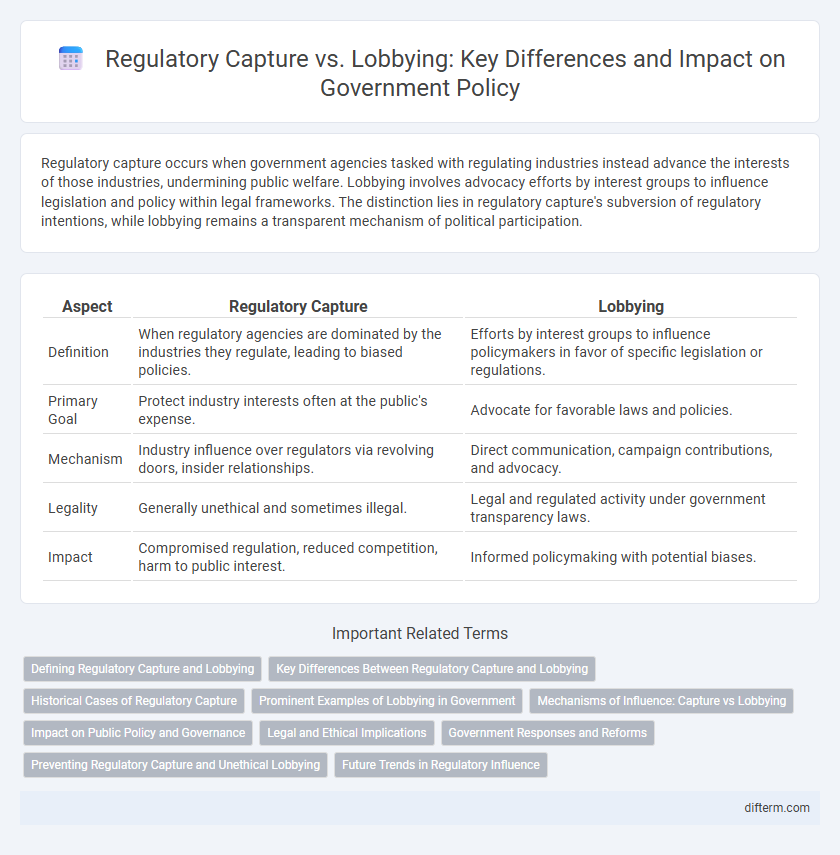Regulatory capture occurs when government agencies tasked with regulating industries instead advance the interests of those industries, undermining public welfare. Lobbying involves advocacy efforts by interest groups to influence legislation and policy within legal frameworks. The distinction lies in regulatory capture's subversion of regulatory intentions, while lobbying remains a transparent mechanism of political participation.
Table of Comparison
| Aspect | Regulatory Capture | Lobbying |
|---|---|---|
| Definition | When regulatory agencies are dominated by the industries they regulate, leading to biased policies. | Efforts by interest groups to influence policymakers in favor of specific legislation or regulations. |
| Primary Goal | Protect industry interests often at the public's expense. | Advocate for favorable laws and policies. |
| Mechanism | Industry influence over regulators via revolving doors, insider relationships. | Direct communication, campaign contributions, and advocacy. |
| Legality | Generally unethical and sometimes illegal. | Legal and regulated activity under government transparency laws. |
| Impact | Compromised regulation, reduced competition, harm to public interest. | Informed policymaking with potential biases. |
Defining Regulatory Capture and Lobbying
Regulatory capture occurs when government agencies intended to regulate industries instead advance the interests of those industries, compromising public welfare. Lobbying involves organized efforts by individuals or groups to influence policymakers and legislation, often representing specific business or social interests. While lobbying is a legitimate democratic practice, regulatory capture represents a distortion of regulatory purpose, where regulatory bodies become dominated by the very entities they are supposed to oversee.
Key Differences Between Regulatory Capture and Lobbying
Regulatory capture occurs when regulatory agencies act in favor of the industries they are supposed to regulate, prioritizing corporate interests over public welfare, whereas lobbying involves influencing policymakers through advocacy and information to shape legislation or regulations. Unlike lobbying, which operates through transparent interactions and legal frameworks, regulatory capture results in agencies losing objectivity and becoming dominated by the entities they regulate. Key differences include intentionality, with lobbying representing strategic influence efforts, and regulatory capture reflecting a systemic failure of regulatory independence and enforcement.
Historical Cases of Regulatory Capture
Historical cases of regulatory capture reveal how industries like the railroad sector in the late 19th century manipulated government agencies to serve corporate interests rather than public welfare. The Teapot Dome scandal in the 1920s demonstrated oil companies influencing government officials to secure exclusive drilling rights on public lands, highlighting severe conflicts of interest. These examples illustrate the fine line between lobbying and regulatory capture, where regulatory agencies become dominated by the very industries they are supposed to oversee.
Prominent Examples of Lobbying in Government
Prominent examples of lobbying in government include the influence of pharmaceutical companies on healthcare legislation, as seen with organizations like the Pharmaceutical Research and Manufacturers of America (PhRMA) investing millions in lobbying efforts to shape drug pricing policies. The fossil fuel industry, represented by groups such as the American Petroleum Institute (API), exerts considerable lobbying power to impact environmental regulations and energy policies. Tech giants like Google and Facebook frequently engage in lobbying to address data privacy laws and antitrust regulations, demonstrating the significant role lobbyists play in shaping government decisions across various sectors.
Mechanisms of Influence: Capture vs Lobbying
Regulatory capture occurs when regulatory agencies prioritize the interests of the industries they oversee due to close relationships and revolving door employment, leading to biased policy enforcement. Lobbying involves organized advocacy by interest groups seeking to influence legislation or regulatory decisions through information provision, campaign contributions, and strategic communication. Both mechanisms shape government outcomes but differ in transparency and intent, with capture undermining regulatory impartiality while lobbying functions within formal political processes.
Impact on Public Policy and Governance
Regulatory capture occurs when regulatory agencies prioritize the interests of the industries they oversee, leading to policies that may undermine public welfare and weaken regulatory effectiveness. Lobbying, when conducted transparently, enables stakeholders to inform lawmakers, but excessive or opaque lobbying can skew public policy toward special interests, eroding trust in governance. Both phenomena shape policy outcomes by influencing rule-making processes, potentially compromising accountability and equitable public interest representation.
Legal and Ethical Implications
Regulatory capture occurs when government agencies tasked with regulating industries become dominated by the interests they are supposed to oversee, leading to biased rule-making and enforcement that favors private entities over public welfare. Lobbying, while a legitimate avenue for interest groups to present information and influence policy, risks crossing ethical boundaries when it results in disproportionate access or corrupt influence that undermines democratic principles and accountability. Legal frameworks aim to mitigate these risks through transparency requirements, conflict of interest laws, and restrictions on gifts and campaign contributions to prevent undue influence and maintain regulatory integrity.
Government Responses and Reforms
Government responses to regulatory capture and lobbying include implementing stricter transparency laws and enhancing oversight mechanisms within agencies. Reforms such as mandatory disclosure of lobbyist activities, revolving door restrictions, and independent watchdog commissions aim to reduce undue influence on policymakers. Strengthening conflict-of-interest rules and promoting citizen engagement are crucial steps for ensuring regulatory decisions serve public interest rather than special interests.
Preventing Regulatory Capture and Unethical Lobbying
Preventing regulatory capture and unethical lobbying requires implementing strict transparency measures, including mandatory public disclosure of lobbying activities and financial contributions. Establishing independent regulatory agencies with robust oversight mechanisms and conflict-of-interest rules minimizes undue influence by specific industries. Enforcing severe penalties for violations deters corrupt practices and promotes accountable governance.
Future Trends in Regulatory Influence
Emerging future trends in regulatory influence highlight increasing concerns over the sophisticated blend of regulatory capture and lobbying, where industry insiders shape policies to favor specific interests. Advanced data analytics and AI-driven strategies enable lobbyists to target regulators more precisely, intensifying the risk of regulatory capture. Strengthening transparency measures and adopting real-time monitoring technologies are critical to mitigating undue influence and preserving regulatory integrity.
Regulatory Capture vs Lobbying Infographic

 difterm.com
difterm.com